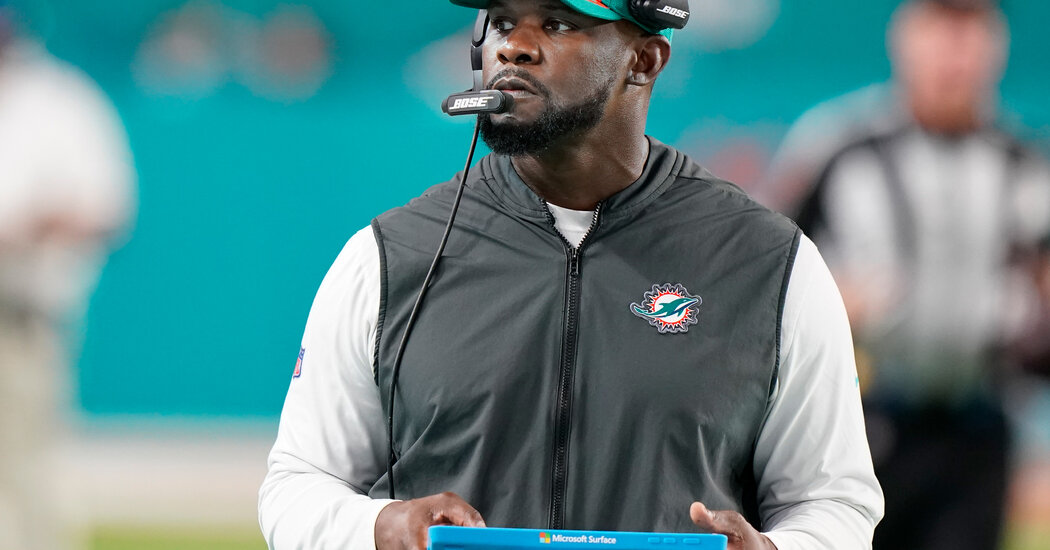Most of its players are Black. Only one head coach is.
Second and even third chances are not that unusual for N.F.L. head coaches. Over their careers, several coaches have run three different teams, and most of them had only mixed records of success before getting the third job. If they had excelled in one of the earlier two jobs, after all, they might have still had it.
The list of coaches to have run at least three teams without having won a Super Bowl includes John Fox, Ted Marchibroda, Wade Phillips, Dan Reeves, Marty Schottenheimer and Norv Turner.
Football fans might notice something about that list: All the coaches on it are white. No Black man has ever been the head coach of three N.F.L. teams. (Romeo Crennel is the closest, having been the coach of two teams and the interim coach of a third team, for part of a season.)
But there are certainly Black coaches whose records resemble those of the white coaches who have had multiple coaching chances. Jim Caldwell, Marvin Lewis, Anthony Lynn, Lovie Smith and, in an earlier era, Dennis Green and Art Shell all won more games than they lost and took teams to the playoffs. They never got a third chance or, in some cases, a second chance to be a head coach.
The Flores lawsuit
Brian Flores seemed as if he might be following this path. Three years ago, he took over the Miami Dolphins, after the team had only one winning season in the previous 10. Under Flores, Miami had a winning record each of the past two years, coming close to the playoffs both times. Still, the Dolphins fired him last month, and no other team has hired him.
On Tuesday, Flores sued the N.F.L. for racial discrimination. It was a remarkable act of defiance: Flores is only 40 years old, and he is probably hurting his chances of getting another job in the insular, conservative N.F.L. — which also happens to be arguably the country’s most popular form of entertainment.
“It’s hard to speak out,” Flores said on CBS yesterday. “But,” he added, “this is bigger than football. This is bigger than coaching.”
Robert Griffin III, a former quarterback, tweeted: “Brian Flores effectively had to end his chances at coaching in the N.F.L. to point out what we already know about discrimination in the hiring process for head coaches in the N.F.L.”
The details of the lawsuit read like something out of a television drama. They include screenshots of an alleged text exchange last month in which Bill Belichick, the league’s most successful coach, mistakenly congratulated Flores on getting the job as the head coach of the New York Giants. (Belichick has not confirmed that the exchange happened.)
Flores believes that Belichick meant to send the text to a different coach named Brian — Brian Daboll, who is white. Flores said that when he received the text, he was preparing for his own interview with the Giants. When he realized the text was not intended for him, he understood that Giants executives had already chosen somebody else.
Why might the Giants have wanted to interview Flores after having decided to hire Daboll? The N.F.L. requires every team to interview at least one nonwhite candidate for any head coaching job. By conducting a pro forma interview with Flores, the Giants would have been technically following the rule.
Lewis, the former coach of the Cincinnati Bengals, said yesterday that he once had a sham interview with the Carolina Panthers. Lewis said that they had already decided to hire Fox — one of the white coaches who would eventually run three different teams.
Evidence of racism
Finding ironclad proof of racial discrimination is rarely easy, especially in an individual case. And not every allegation of racism is accurate or fair. But the evidence that the N.F.L. has engaged in a pattern of discrimination against Black coaches is strong:
-
A 2019 academic analysis commissioned by the N.F.L. confirmed that Black coaches were less likely to receive second chances. “In the NFL,” The Atlantic’s Jemele Hill recently wrote, “Black coaches are expected to perform miracles quickly, and when they don’t, it usually costs them their job.”
-
In a 32-team league where most players are Black — and that has long been the case — only one current head coach is Black. He is Mike Tomlin, who has one of the highest winning percentages of any active coach.
-
Teams have also been reluctant to hire Black coaches as offensive coordinator — a job that often leads to head coaching positions, as Tyler Tynes noted in The Ringer. An academic study concluded that the low rate at which teams hired Black candidates for coordinator jobs was the No. 1 reason that white head coaches dominate the league.
-
Even when Black coordinators succeed in those jobs, they are sometimes passed over for white candidates with weaker résumés. In last year’s Super Bowl, both offensive coordinators — Eric Bieniemy of the Kansas City Chiefs and Byron Leftwich of the Tampa Bay Buccaneers — were Black. Neither has become a head coach, even as 14 teams have hired new coaches since the end of last season.
For more
Kurt Streeter has written about Bieniemy’s sterling coaching credentials, and Robert O’Connell has explained Leftwich’s success.
The Times has broken several stories on emails among prominent N.F.L. figures — involving racist remarks from Jon Gruden, a longtime coach; and a joke by the N.F.L.’s top lawyer that outreach to Latino fans would be less relevant after the construction of a border wall.
A programming note: Starting this weekend, The Morning expands to seven days a week. Melissa Kirsch will write on Saturdays about culture and German Lopez on Sundays about big stories and ideas.
THE LATEST NEWS
The Virus
-
Researchers are developing nasal spray vaccines. Because they protect the airways (where the virus enters the body) they may be better at preventing infections.
-
The Army said it would immediately discharge unvaccinated soldiers.
-
The Times spent a day in the I.C.U. at a London hospital.
Politics
-
Democrats in the New York State Legislature approved maps that could gain their party as many as three House seats from Republicans.
-
The Pentagon said it carried out a “successful” counterterrorism raid in Syria. Reports suggested civilians may have been killed.
-
Memos written two weeks after the election show Trump campaign officials plotting to overturn the result.
-
More House Democrats want to ban members of Congress from trading stocks, breaking with party leaders.
-
President Biden announced a revival of his “moonshot” program to reduce cancer deaths.
Business and Media
-
Jeff Zucker resigned as the president of CNN over a romantic relationship with an executive.
-
Meta, formerly Facebook, said its virtual reality division lost more than $10 billion last year.
Other Big Stories
-
The U.S. is deploying 3,000 more troops to Eastern Europe. And President Vladimir Putin pledged to deepen ties between Russia and China.
-
More than 1 million people have fled Afghanistan as its economy collapses.
-
Four men were charged in connection with the fentanyl-laced heroin that killed the actor Michael K. Williams.
-
The Washington Football Team will rebrand as the Commanders, nearly two years after dropping its longtime name.
-
A winter storm moving across three U.S. time zones will cause a second day of disruptions.
Opinions
Eric Adams’s politics are hard to place on a left-right spectrum. But they’re familiar to many Black Americans, Christina Greer writes.
“I made a stand because I could”: Roxane Gay on pulling her podcast off Spotify to protest Covid misinformation.
Donald Trump (like Nancy Pelosi and John Fetterman) keeps asking Gail Collins for money.
MORNING READS
Global shortage: Where have all the flowers gone?
Tech: Laser vacuums show you more dirt than you may want to see.
Screenland: Why is Matt Damon shilling for crypto?
Ask an ethicist: Is it OK that she’s OK with her mother’s adultery?
A Times classic: How to make the most of your doctor’s appointment.
Lives Lived: Monica Vitti starred in a series of 1960s masterpieces directed by Michelangelo Antonioni, including “L’Avventura.” She died at 90.
ARTS AND IDEAS
Hollywood’s liberated era
There was a slip of time in Hollywood, between the silent era and the summer of 1934, when actresses embodied roles with ahead-of-their-time understandings of womanhood, going beyond the stereotypes of vamp or ingénue. It was before the Production Code Administration, which imposed strict censorship, “began to put a stranglehold on the industry,” Beatrice Loayza writes in The Times.
Pre-Code films weren’t more risqué out of a desire to be progressive, but rather to “draw in Depression-era audiences with sheer titillation,” Loayza writes. Still, that often led to more complex female characters, as in the 1931 drama “Bad Girl.” After the character Dorothy (Sally Eilers) stays at a man’s place until 4 a.m., her brother kicks her out of the apartment they share. Her brother’s girlfriend, Edna (Minna Gombell), a single mother, proceeds to dump him and take Dorothy under her wing.
These characters “were not only more sexually liberated than their Code-bound successors, they were also unapologetically independent and skeptical or outright dismissive of norms and institutions like marriage in ways that went unpunished,” Loayza writes.
If you’re in New York: A film series at the Museum of Modern Art is screening some of these pre-Code titles.
PLAY, WATCH, EAT
What to Cook
Cauliflower isn’t boring in this cashew coconut curry.
What to Read
In Julia May Jonas’s first novel, “Vladimir,” a married literature professor becomes obsessed with a younger experimental writer.
What to Listen to
Reggae, house, step, ballet, tap, jazz: Listen to the music that inspired great choreographers.
Late Night
The hosts commented on the Washington Commanders.
Now Time to Play
The pangrams from yesterday’s Spelling Bee were compile and polemic. Here is today’s puzzle — or you can play online.
Here’s today’s Mini Crossword, and a clue: “Opposable” body part (five letters).
If you’re in the mood to play more, find all our games here.
Thanks for spending part of your morning with The Times. See you tomorrow. — David
P.S. The Morning is holding a live online event on March 9 and welcomes your Tiny Love Stories. Read more — and please join us.
Here’s today’s front page.
“The Daily” is about ISIS. And a new podcast from the creators of “Serial” — called “The Trojan Horse Affair” — investigates a supposed Islamist plot to infiltrate British schools.
Claire Moses, Ian Prasad Philbrick, Tom Wright-Piersanti, Ashley Wu and Sanam Yar contributed to The Morning. You can reach the team at themorning@nytimes.com.












